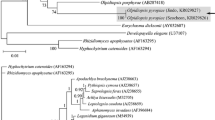Abstract
Oomycetes are one of the most serious pathogens that threaten global aquaculture industry, and they cause two out of three most common diseases in Pyropia farms. Recent study showed that Olpidiopsis disease occurring in Pyropia farms in Korea and Japan is caused by different endemic Olpidiopsis species, O. porphyrae in Japan, and O. pyropiae in Korea. From 3 years of epidemiological studies in Pyropia sea farms, we found an additional Olpidiopsis variety causing disease in Pyropia farms in Korea and named it O. porphyrae var. koreanae. It was a clearly different species from previously reported O. pyropiae in 18S rRNA gene sequence (91.0% of identity) and a different variety from Japanese O. porphyrae, which unlike Korean variety had four introns in18S rRNA gene. In our new strain, one more fifth intron was inserted between introns 2 and 3. The sequence similarity of introns ranged from 92.7 to 100%. The ultrastructure, infection process, and asexual life history of this new variety were similar to previously reported Olpidiopsis species, except for the size of zoospores. Phylogenetic analysis using 18S rRNA and cox genes showed that three Pyropia-infecting Olpidiopsis formed a group which had a loose affinity with the other marine Olpidiopsis spp.






Similar content being viewed by others
References
Bhattacharya D, Reeb V, Simon DM, Lutzoni F (2005) Phylogenetic analyses suggest reverse splicing spread of group I introns in fungal ribosomal DNA. BMC Evol Biol 5:68
Choi Y-J, Beakes G, Glockling S, Kruse J, Nam B, Nigrelli L, Ploch S, Shin H-D, Shivas RG, Telle S, Voglmayr H, Thines M (2015) Towards a universal barcode of oomycetes—a comparison of the cox1 and cox2 loci. Mol Ecol Res 15:1275–1288
Fletcher K, Žuljevic A, Tsirigoti A, Antolic B, Katsaros C, Nikolic V, van West P, Küpper FC (2015) New record and phylogenetic affinities of the oomycete Olpidiopsis feldmanni infecting Asparagopsis sp. (Rhodophyta). Dis Aquat Org 117:45–57
Gretz MR, Mccandless EL, Aronson JM, Sommerfeld MR (1983) The galactan sulphates of the conchocelis phases of Porphyra leucostricta and Bangia atropurpurea (Rhodophyta). J Exp Bot 34:705–711
Haugen P, Simon DM, Bhattacharya D (2005) The natural history of group I introns. Trends Genet 21:111–119
Kim GH, Moon K-H, Kim J-Y, Shim J, Klochkova TA (2014) A revaluation of algal diseases in Korean Pyropia (Porphyra) sea farms and their economic impact. Algae 29:249–265
Klochkova TA, Shim JB, Hwang MS, Kim GH (2012) Host-parasite interactions and host species susceptibility of marine fungal parasite, Olpidiopsis sp., from Korea that infects red algae. J Appl Phycol 24:135–144
Klochkova TA, Jung S, Kim GH (2016a) Host range and salinity tolerance of Pythium porphyrae may indicate its terrestrial origin. J Appl Phycol. doi:10.1007/s10811-016-0947-8
Klochkova TA, Shin YJ, Moon K-H, Motomura T, Kim GH (2016b) New species of unicellular obligate parasite, Olpidiopsis pyropiae sp. nov., that plagues Pyropia sea farms in Korea. J Appl Phycol 28:73–83
Logsdon JM, Stoltzfus JA, Doolittle WF (1998) Molecular evolution: recent cases of spliceosomal intron gain? Curr Biol 8:R560–R563
Lynch M (2002) Intron evolution as a population-genetic process. PNAS 99:6118–6123
Machouart M, Gueidan C, Khemisti A, Dulongcourty R, Sudhadham M, De Hoog GS (2011) Use of ribosomal introns as new markers of genetic diversity in Exophiala dermatitidis. Fung Biol 115:1038–1050
Mukai LS, Craigie JS, Brown RG (1981) Chemical composition and structure of the cell walls of the conchocelis and thallus phases of Porphyra tenera (Rhodophyceae). J Phycol 17:192–198
Nagasato C, Motomura T (2002) Ultrastructural study on mitosis and cytokinesis in Scytosiphon lomentaria zygotes (Scytosiphonales, Phaeophyceae) by freeze-substitution. Protoplasma 219:140–149
Robideau GP, De Cock AW, Coffey MD, Voglmayr H, Brouwer H, Bala K, Chitty DW, Désaulniers N, Eggertson QA, Gachon CM, Hu CH, Küpper FC, Rintoul TL, Sarhan E, Verstappen EC, Zhang Y, Bonants PJ, Ristaino JB, Lévesque CA (2011) DNA barcoding of oomycetes with cytochrome c oxidase subunit I and internal transcribed spacer. Mol Ecol Resour 11:1002–1011
Ronquist F, Huelsenbeck JP (2001) MRBAYES: Bayesian inference of phylogenetic trees. Bioinformatics 17:754–755
Sekimoto S, Hatai K, Honda D (2007) Molecular phylogeny of an unidentified Haliphthoros-like marine oomycete and Haliphthoros milfordensis inferred from nuclear-encoded small- and large-subunit rRNA genes and mitochondrial-encoded cox2 gene. Mycoscience 48:212–221
Sekimoto S, Yokoo K, Kawamura Y, Honda D (2008) Taxonomy, molecular phylogeny, and ultrastructural morphology of Olpidiopsis porphyrae sp. nov. (oomycetes, Straminipiles), a unicellular obligate endoparasite of Bangia and Porphyra spp. (Bangiales, Rhodophyta). Mycol Res 112:361–374
Sekimoto S, Klochkova TA, West JA, Beakes GW, Honda D (2009) Olpidiopsis bostrychiae sp. nov.: an endoparasitic oomycete that infects Bostrychia and other red algae (Rhodophyta). Phycologia 48:460–472
Stamatakis A (2014) RAxML version 8: a tool for phylogenetic analysis and post-analysis of large phylogenies. Bioinformatics 30:1312–1313
Ueki C, Nagasato C, Motomura T, Saga N (2008) Reexamination of the pit plugs and the characteristic membranous structures in Porphyra yezoensis (Bangiales, Rhodophyta). Phycologia 47:5–11
Usov AI (2011) Polysaccharides of the red algae. Adv Carbohydr Chem Biochem 65:115–217
West JA, Klochkova TA, Kim GH, Loiseaux-de Goër S (2006) Olpidiopsis sp., an oomycete from Madagascar that infects Bostrychia and other red algae: host species susceptibility. Phycol Res 54:72–85
Xu C, Wang C, Sun X, Zhang R, Gleason ML, Eiji T, Sun G (2013) Multiple group I introns in the small-subunit rDNA of Botryosphaeria dothidea: implication for intraspecific genetic diversity. PLoS One 8(7):e67808
Acknowledgements
This work was supported by a National Research Foundation of Korea Grant (NRF-2015M1A5A1041804) funded to GHK. This research was also supported by Golden Seed Project, Ministry of Agriculture, Food and Rural Affairs funded by Ministry of Oceans and Fisheries, Korea.
Author information
Authors and Affiliations
Corresponding author
Electronic supplementary material
ESM 1
(PDF 220 kb)
Rights and permissions
About this article
Cite this article
Kwak, M.S., Klochkova, T.A., Jeong, S. et al. Olpidiopsis porphyrae var. koreanae, an endemic endoparasite infecting cultivated Pyropia yezoensis in Korea. J Appl Phycol 29, 2003–2012 (2017). https://doi.org/10.1007/s10811-017-1109-3
Received:
Revised:
Accepted:
Published:
Issue Date:
DOI: https://doi.org/10.1007/s10811-017-1109-3




